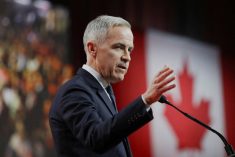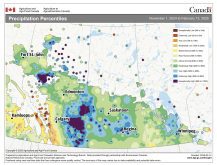The number and scale of utility grade solar and wind projects in Alberta either in service or projected to be energized in the next few years is exceeding expectations of renewable energy supporters.
The projects include the 466-megawatt capacity Lone Pine wind project in Hanna, the 360-megawatt Solar Krafte development in Brooks and battery storage projects that could potentially hold more than 1,000 megawatts of renewable energy production.
“What we’re seeing in Alberta is mirrored with what we are seeing around the world,” said Sara Hastings-Simon, University of Calgary assistant professor specializing in energy transitions, electricity systems and carbon pricing.
Read Also

Flax sector sees omega-3 opportunity
SASKATOON — A global shortage of omega-3 oils could be an opportunity for the flax sector, says an industry official….
The amount of solar electricity production worldwide is exponentially expanding, said Hastings-Simon, and the cost of solar panels continues to drop.
“We’ve seen the prices of solar continuing to fall over the past years and now to a level where they’re competitive with other forms of generation,” she said.
More than 100 renewable energy projects are currently approved or working their way through the regulatory approval through the Alberta regulator, Alberta Electric System Operator.
Between Oct. 1 and Nov. 29, eight wind projects with a combined 874 megawatts of capacity and seven solar projects with a total of 114 megawatts of capacity have been energized in Alberta, according to AESO.
An advantage of solar is the maximum energy profile of the power source syncs up well with the summertime peak electricity demand in Alberta.
In Alberta’s deregulated energy market, that also translates to peak prices for energy companies that aren’t diminished by large emitter carbon pricing and a healthy return on investment.
“It’s also helping to bring down the cost of electricity for everybody in providing energy when it’s most needed,” said Hastings-Simon.
While some detractors point to Ontario’s early experience with subsidizing solar projects, Alberta’s deregulated market has the energy source being able to compete on its own merits.
“It’s a totally different market in a totally different time,” Hastings-Simon said of the Ontario experience.
There may be a need for governments to support new economic sectors from time to time but that’s not necessarily the case in Alberta currently when it comes to renewable energy.
“While the prices of power from fossil fuel sources like natural gas have been flat or increasing, the price of solar has fallen quite dramatically over the past decade and continues to fall,” said Hastings-Simon. “This is private actors deciding to install solar. They are really doing so on the basis of the business case.”
In the last two years alone for both wind and solar, Hastings-Simon said there has been $3.75 billion revenue generated through the private sector in contracted electricity production in the province.
“There is clearly a business here and there is clearly investment flowing into that. This is not an Alberta only phenomenon,” she said.
She added while Alberta is dominating the sector due to its deregulated market that allows direct investment by the private sector, renewables in the rest of the country are seeing substantial growth.
“When it comes to proving the naysayers wrong, it’s really just about seeing the investment flowing into the projects and being built and developed and being, over the past year, incredibly profitable,” said Hastings-Simon.
Alberta, one of the first provinces to collect a carbon tax are large scale emitters, will be tripling the cost of its price-per-tonne of CO2 emissions by 2030 to conform with federal regulations that aim to cut greenhouse gas production.
In 2023, the cost will rise to $65 per tonne until it reaches $170 per tonne with costs rising by $15 annually.
That situation will allow renewable energy projects to monetize their low-carbon energy production, said Hastings-Simon, cautioning that situation might be a double-edged sword.
“As the carbon price scales up, the value of being a low-carbon electricity resource grows. However, on the other hand, Canada with its 2035 net-zero target for the electricity system would tend to scale down the value of that difference between solar, wind and other forms of generation.”
But Hastings-Simon stressed the 2035 goal is to be net-zero with there still being the need to generate electricity though sources such as natural gas because challenges to achieving a carbon-free system remain.
“And when people think about managing variable renewables… and we need other sources to fill in there, those challenges are manageable with the technology we have today up until the 75 to 80 percent range,” she said. “It gets much harder to get to the 90, 95, 100 percent range.”
Alberta is set to exceed its legislated goal of reaching 30 percent of its electricity production being produced by renewable energy by 2030.
The provincial government’s target of reaching 26 percent by 2028 is anticipated to be met in 2023.
















